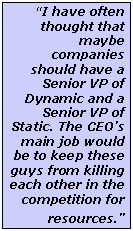Now that we are in the 21st century,
I have spent a lot of time thinking about the nature of the typical business
organization.It seems to me that when you step back and look, there are
two types of activities in business.Dynamic, which are areas like sales,
marketing, new product development, business expansion (Real Estate development)
and strategies, and then there is Static, which are areas like finance,
HR, operations and legal.

It appears to me, that in many ways,
these categories are basically incompatible.The goals and mindsets of
Static and Dynamic are entirely different, but because this is the way
thing are, the status quo is considered "normal". As a result, there
are some really dumb divisions of labor that inhibit the organization.
One of the dumbest is the structure of information technology (IT).In almost every company in the world, IT reports to Finance.What should be a very high tech and extremely dynamic group reports to and is funded by a discipline in which the last major advance was double entry bookkeeping 200 years ago.True, the general ledger is a mission critical application, but what has really changed in that software paradigm since the general ledger ran in Cobol on a System 38? Not much.While finance should have it's due, why aren't there two IT departments, one for IT which is sort of the company's hard drive and the other one for the rest of the business which needs graphics, GIS and mobile apps? How can one of most dynamic technology areas in recent human history (IT) report to one of the most static (finance)?
Pondering further, I have often thought that maybe companies should recognize this division and have a Senior VP of Dynamic for the dynamic side and a Senior VP of Static for the static side.The CEO's main job would be to keep these guys from killing each other in the competition for resources.It is quite likely that VP of Static would have some wordsmith adjust static to a more interesting word as no one would want static in their title.How about VP of Dynamic Support, I'm sure that will fly.
When companies start out as some entrepreneur operation, the business is almost 100% dynamic and in that environment are where are found the "Wow companies".Successful companies of this type, have a vision, run fast, can accommodate change quickly and grow quickly until someone says, "boy, we need to get organized".I'll bet that is usually the accounting guy - wanting to be the new VP of Static. Then the path is altered to sell out to some larger group, take the money and run and even if the products are viable, the rate of growth lessens and "The Wow" goes away and Static is entrenched.
It isn't that I am down on accountants or HR types or even lawyers, it is just that if consumer's tolerance for marginality is lower today and their mobility is greater companies need to be faster on their feet in the adoption of new technologies.It is not just IT or Finance that needs to change; it is the entire organization.
You have to ask, is the allocation of resources across the organization right for the times or are we too weighted toward static and the way things were? Perhaps, what is needed is "Dynamicization" (a new word) of the organization to address the way thing are.
Soon, if not already, your office will be in the Palm of your hand (pun intended).As a consumer, you will buying products before you get to the store - on the fly, and expect them to be waiting for you - with the order filled correctly.Circuit City allows you to do this via their web site.Find the product, buy it, and pick it up at the store.If your PDA can wireless browse the web, you could buy the product on the way to Circuit City.I wonder how their IT group is organized? Are they PDA-enabled or just a little closer to now than we are.
As we learned from Simple Stuff #10, today's consumer wants speed, quality, consistency, and flexibility.Logic indicates that our current organization is probably wrong and is too stiff to adapt easily.
Remember, that one of the really cool things about business evolution is that there is more room for change and change can happen faster than we ever imagine.The future may be in the Palm of your hand (or CE powered).
Next time here at Simple Stuff we'll talk about visualization.Believe it or not, this is an area where IT will be invaluable.Note, that it is hard to know what is going on without being able to see it.I think this is an area where we have not done very well and visualization along with IT may be the key to effecting real change.